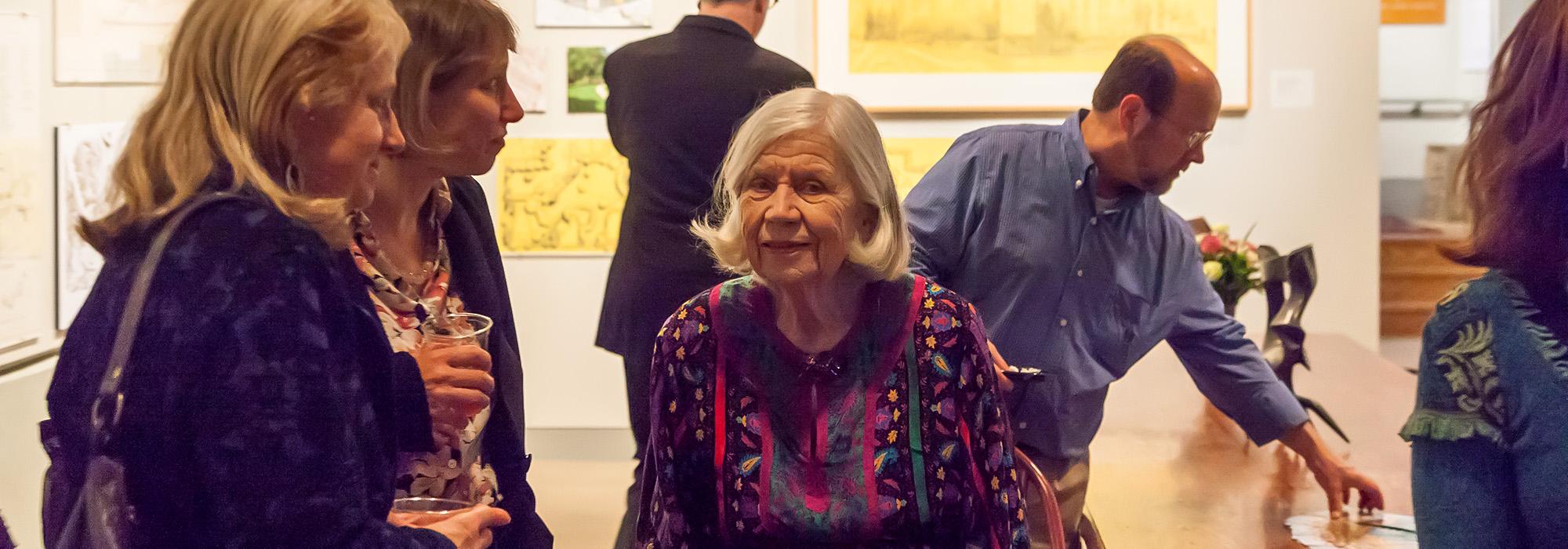The Cultural Landscape Foundation Releases New Pioneers Oral History with Landscape Architect Harriet Pattison
Media Contact: Nord Wennerstrom | T: 202.483.0553 | M: 202.225.7076 | E: nord@tclf.org
Pattison Project is the 13th in the ongoing Pioneers Video Oral History series that documents, collects, and preserves first-hand information from pioneering landscape architects/educators
Washington, DC (April 19, 2016) – The Cultural Landscape Foundation (TCLF) today announces the release of a new Pioneers of American Landscape Design® video oral history with acclaimed landscape architect Harriet Pattison, which will be formally unveiled this evening at an event in conjunction with the opening of the exhibition Harriet Pattison: Gardens & Landscapes at the Harvey & Irwin Kroiz Gallery in the Architectural Archives of the University of Pennsylvania School of Design. This is the 13th in the award-winning Pioneers series, which TCLF launched in 2003 to document, collect, and preserve first-hand information from pioneering landscape architects/educators. In practice for more than 50 years, Pattison worked on residential gardens, public housing, and a variety of projects, including the 125-acre Hershey Food Corporation campus. Other career milestones include the Kimbell Art Museum in Fort Worth, TX, with landscape architect George Patton and architect Louis Kahn, and the Franklin D. Roosevelt Four Freedoms Park in New York City, again with Kahn.
The project documents Pattison’s life and career, including her formative years in Chicago and Maine, her major influences and significant projects. The 93-minute oral history is divided into 32 one-to-four-minute clips that cover biography, design, and built projects. In it, she reflects on attending Yale (with classmate Paul Newman), travels in Europe, witnessing the coronation of Elizabeth II, and her first meeting with architect Louis Kahn on a snow-covered street in New Haven. Newly discovered still photography and film illustrate the environment at Dan Kiley’s office in Vermont, where she resided and worked following the birth of her and Kahn’s son, Nathaniel. Pattison discusses major practitioners and educators and their influence on her, and talks candidly about the impact of the Renzo Piano-designed addition on the landscape she and George Patton designed at the Kimbell Art Museum. In an emotional clip, she talks about how the completion of Four Freedoms Park brought a new level of professional recognition, personal peace and fulfillment, and a memorable meeting with former President Bill Clinton.
The goal of this ongoing series, thrice supported with grants from the National Endowment for the Arts (NEA) Art Works program, is to make these practitioners’ stories available to future generations of stewards, designers, researchers, and heritage travelers. The series format examines each designer’s personal and professional history, their overall design philosophy, and how that approach was carried out in their most emblematic projects. Richly edited, the video segments include never-before-seen archival footage, new photography, and on‐location videography. The oral history includes a downloadable transcript and recollections by friends and colleagues. Past oral history subjects include Lawrence Halprin, Carol R. Johnson, Cornelia Hahn Oberlander, Laurie Olin, and James van Sweden. In 2010, the American Society of Landscape Architects presented the series with the highest honor in the Communication's Category, the Award of Excellence.
“Harriet Pattison, has been overshadowed by Louis Kahn and shares the responsibility, but not the credit, for the creation of two Modernist icons,” said Charles A. Birnbaum, TCLF’s president & CEO. “The goal of this Pioneers Oral history series is to make Pattison’s unique and inspiring story and design legacy visible and valued.”
Videotaping was conducted at the University of Pennsylvania Archives and on location at various built works in June 2015. Production is by Gina Angelone, an award-winning filmmaker and Emmy nominee, who is in her seventh collaboration with TCLF. Angelone has written and directed feature-length documentaries—René & I (2005) and It's Better To Jump (2013)—was producer of Bravo’s Inside the Actor’s Studio, produced live Broadway shows for the Disney Channel, and has written, produced, and directed television commercials and large-scale media presentations for Fortune 500 corporations. Her first project with TCLF was the documentary Connections: Preserving America's Landscape Legacy, which aired on PBS stations nationwide and for which she was writer, producer, and director. Her most recent work with TCLF includes oral histories with Shlomo Aronson, Joe Yamada, and Laurie Olin. James Callanan was the principle videographer, and Barrett Doherty, TCLF’s visual content director, conducted additional videotaping and post-production editing; Brian Cho scored the oral history.
The oral history was made possible by grants from the National Endowment for the Arts (NEA) Art Works program and the Hubbard Educational Foundation, and support from Nathaniel Kahn and Leslie Rose Close.
The American Society of Landscape Architects is the Annual Sponsor.
About The Cultural Landscape Foundation
The Cultural Landscape Foundation (TCLF), founded in 1998, is a non-profit foundation that provides people with the ability to see, understand and value landscape architecture, its practitioners, and our shared landscape legacy in the way many people have learned to do with buildings and their designers. Through its website, lectures, outreach and publishing, TCLF broadens the support and understanding for cultural landscapes nationwide. TCLF makes a special effort to heighten the awareness of those who impact cultural landscapes, assist groups and organizations working to increase the appreciation and recognition of cultural landscapes, and develop educational tools for young people to better connect them to their cultural landscape environs.
# # #



